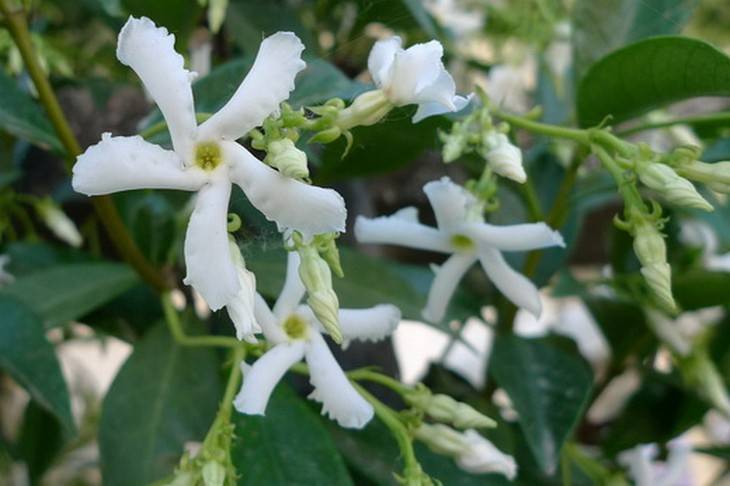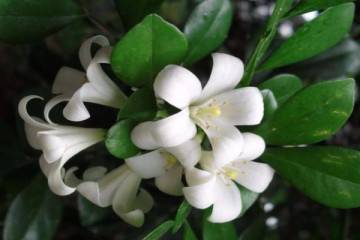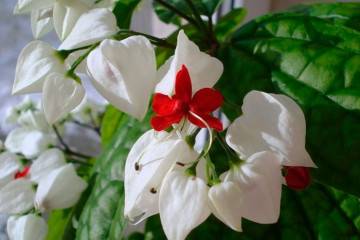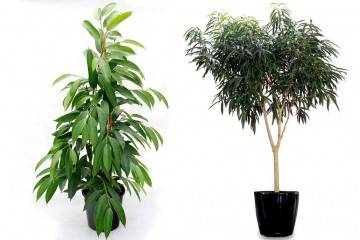Indoor jasmine - home care
Content:
Indoor jasmine belongs to the category of perennial evergreens. Beautiful flowers are naturally endowed with an amazing, pronounced aroma. Most of the indoor varieties pleases with long flowering and lack of difficulties in care.
Description and history
The decorative culture is widespread in South America and Australia. Jasmine leaves are attractive enough. The whole-edge foliage is endowed by nature with oval-oblong outlines with pointed tips. The classic evergreen crown of plants looks quite impressive. Double flowers of the tubular type have deeply dissected and wide-open corollas, which are divided into 6 petals. The cylindrical tube is practically hidden under the petals.
Flowers can be colored in:
- pink;
- cream;
- yellow;
- white tones.
Common varieties
Below are the most popular varieties of indoor jasmine, which have fallen to the taste of indoor flower lovers.
Jasmine Sambac
Jasmine Sambac belongs to the category of unpretentious and easy-to-grow jasmine varieties. The length of the shoots can reach 550-600 cm. The branches become lignified and pubescent over time. Ovoid leaf plates can be collected in whorls. Fragrant flowers, painted in white tones, can be either double or semi-double.
When does jasmine bloom, which has similar features to the mock orange? Flowering lasts from March to mid-autumn. Sambac is a real miracle. Its aroma is reminiscent of expensive perfumery.
Jasmine multiflorous
Multi-flowered jasmine is an indoor flower. The shrub is distinguished by the presence of weakly branching climbing shoots, the length of which can exceed 180 cm. The flower buds are painted in a pink palette. Flowering begins at the end of winter and lasts until the last weeks of August. The multi-flowered cultivar can smell especially bright in summer.
Pink jasmine
The evergreen shrub pleases with a gorgeous flowering in late spring. The length of the longitudinally furrowed branches often exceeds 190 cm. The dark green leaf plates are naturally endowed with oval outlines. Flowers, painted in pink tones, are located in the upper parts of the vine. The pink variety has a very pleasant, delicate aroma.
Madagascar jasmine
The variety of the royal shrub, like the Grand Duke, belongs to the category of abundant flowering plants. Oval leathery foliage is painted in dark green tones. Gorgeous white flowers-stars complement the variety with decorativeness. Flowers are collected in lush bunches. The shrub vine begins to bloom in the spring. The flowering of the Madagascar variety can last 10 months. Caring for indoor jasmine at home is quite simple. The most important thing is to transplant and feed the bushes in time.
Multi-flowered jasmine
The polyanthus shrub (polyantum) is characterized by poorly developed branching. Shoot length can reach 180-200 cm.The top of the oval leaf plates is sharp. The extreme parts are wavy. Tubular flowers dot the top of the bushes. The aroma of the multi-flowered variety is quite rich in comparison with other varieties. After the end of flowering, inedible fruits are tied on the plant instead of buds. With improper care, the variety may not bloom. In Crimea, the variety grows in the garden until early October.
Jasmine
At the end of the first spring month, a large number of tubular flowers, painted in a bright yellow palette, begin to bloom on the shrub of the holo-flowered variety. Long shoots are distinguished by the presence of a greenish bark. The branches, the length of which reaches 300 cm, are rather weak.
Yellow jasmine
The juice of the yellow homemade jasmine flower is poisonous. If you follow the recommendations for plant care, the lower area of the stems will gradually become covered with wood. The flowering of the variety is long. Often, yellow jasmine is mistaken for a chubushnik, which belongs to the Hortensia family.
Jasmine strawberry
A shrub of compact size, naturally endowed with thin shoots. The height of the branches does not exceed 140-150 cm. The annual growth of shoots is in the range of 4-7 cm. Heavy flowers contribute to the sagging of the shoots down. The leaf plates are pointed at the top.
Jasmine virginal
Erect shoots of the shrub can reach a height of 300 cm. The wide crown is distinguished by its increased density. The branches of the Virginal variety are literally dotted with large leaf blades. During the spring and summer months, the foliage is painted in a green palette. With the arrival of autumn, the leaf plates turn yellow and begin to fall off. Double-flowered white flowers reach 5 cm in diameter. This variety is unpretentious. The yellow-leaved plant acquires a special sophistication in the autumn period. In the summer, you can plant bushes in the garden.
Features of jasmine care
Below are the main features of care, the observance of which will help to grow healthy bushes, delighting with long flowering.
- The lighting in the room in which the flower pots are located should be diffused. Whatever time of year it is, the bushes need bright light, the lack of which can be compensated for with the help of phytolamps.
- During the period of intensive growth, it is recommended to observe the temperature regime in the range of 19-22 ° C. In winter, the temperature in the room can be reduced to 12 ° C.
- The soil in the pots is moistened as the top layer of the earth dries. In the spring and autumn, watering twice a week is enough, and in the summer you will have to water every other day.
- It is recommended to maintain high air humidity indoors. Before the beginning of the flowering period, the leaf plates are moistened daily with a spray bottle.
- During the period of active growth, flower growers recommend applying organic and mineral fertilizers 2 times a month. In the autumn months, the frequency of feeding is reduced. In winter, the bushes do not need fertilization. The first time feeding is applied on the day of planting.
- The dormant period of indoor jasmine lasts from November to the end of February.
- With proper care, jasmine is not susceptible to disease. In some cases, pests may appear on the bushes - mealybugs and whiteflies, spider mites.
Winter care
To ensure the best flowering, experts recommend keeping the temperature in the room in the cold season within the range of 12-16 ° C. Watering is reduced during this period to 1 time in 7-10 days.
Bloom
During the flowering period, the room is filled with an amazing, pronounced aroma.In order for the plant to please with abundant flowering, it is necessary to provide proper care for the shrub and systematically apply top dressing.
Jasmine pruning
Ornamental vine needs systematic pruning, which allows the shoots to curl correctly. It is advisable to install at home near containers with flowers, supports made in the form of a semicircle.
Reproduction
You can propagate a plant using the method:
- cuttings;
- air layering;
- by the seed method.
For the rooting of air layers, it is necessary to prepare a small container filled with fertile soil. The pot is exposed near the mother shrub. An incision is made on the lower part of the stem of an adult bush. The incised part is pressed against the surface of the soil of a small container. For this purpose, it is advisable to use studs. Layers need systematic watering. As soon as young sprouts appear in a small container, the cut is cut off from the mother bush.
To apply the grafting method, cuttings are cut from adult bushes, the length of which reaches 15 cm. The cut branches must be placed in a jar filled with water for 4-6 weeks. It is best to dip the slices into the root before doing this. As soon as the roots appear on the cuttings, you can transplant them into separate containers.
Transfer
Young bushes need replanting annually, and mature plants can be replanted every 3 years. A soil mixture consisting of leafy, peat and coniferous soil, a small amount of sand is poured into the pots (it is better to dry it for a couple of days in the sun beforehand). A drainage layer must be laid out on the surface of the bottom of the container.
Possible growing problems
Improper care can cause various problems when growing jasmine. Often, spider mites, whiteflies and aphids can be found on the bushes. It is important to treat green spaces with insecticides as soon as possible.
In addition, there may be problems such as:
- dropping foliage, which occurs against the background of improper watering or exposing the pots to a draft;
- drying of the tips of young shoots and leaf plates due to the strong drying out of the soil;
- gradual drying of shoots, which can occur against the background of the accumulation of a large amount of alkali in the ground.
By properly caring for jasmine, you can grow healthy bushes, which annually will delight with abundant flowering and fill the apartment with an amazing aroma.



















